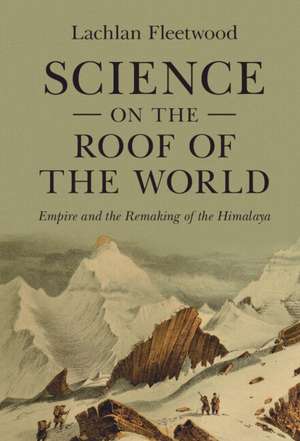Science on the Roof of the World: Empire and the Remaking of the Himalaya: Science in History
Autor Lachlan Fleetwooden Limba Engleză Hardback – 11 mai 2022
Din seria Science in History
-
 Preț: 308.39 lei
Preț: 308.39 lei -
 Preț: 274.69 lei
Preț: 274.69 lei -
 Preț: 406.55 lei
Preț: 406.55 lei -
 Preț: 283.25 lei
Preț: 283.25 lei -
 Preț: 189.99 lei
Preț: 189.99 lei -
 Preț: 306.86 lei
Preț: 306.86 lei -
 Preț: 306.30 lei
Preț: 306.30 lei -
 Preț: 324.96 lei
Preț: 324.96 lei -
 Preț: 324.24 lei
Preț: 324.24 lei -
 Preț: 224.62 lei
Preț: 224.62 lei -
 Preț: 243.15 lei
Preț: 243.15 lei -
 Preț: 288.42 lei
Preț: 288.42 lei -
 Preț: 221.56 lei
Preț: 221.56 lei -
 Preț: 206.39 lei
Preț: 206.39 lei -
 Preț: 230.49 lei
Preț: 230.49 lei - 11%
 Preț: 585.10 lei
Preț: 585.10 lei - 14%
 Preț: 728.56 lei
Preț: 728.56 lei - 9%
 Preț: 593.41 lei
Preț: 593.41 lei - 11%
 Preț: 642.35 lei
Preț: 642.35 lei - 9%
 Preț: 592.87 lei
Preț: 592.87 lei
Preț: 584.57 lei
Preț vechi: 656.82 lei
-11% Nou
Puncte Express: 877
Preț estimativ în valută:
111.87€ • 116.36$ • 92.36£
111.87€ • 116.36$ • 92.36£
Carte tipărită la comandă
Livrare economică 14-28 aprilie
Preluare comenzi: 021 569.72.76
Specificații
ISBN-13: 9781009123112
ISBN-10: 1009123114
Pagini: 294
Dimensiuni: 158 x 235 x 21 mm
Greutate: 0.58 kg
Ediția:Nouă
Editura: Cambridge University Press
Colecția Cambridge University Press
Seria Science in History
Locul publicării:New York, United States
ISBN-10: 1009123114
Pagini: 294
Dimensiuni: 158 x 235 x 21 mm
Greutate: 0.58 kg
Ediția:Nouă
Editura: Cambridge University Press
Colecția Cambridge University Press
Seria Science in History
Locul publicării:New York, United States
Cuprins
Introduction; 1. Measuring Mountains; 2. Unstable Instruments; 3. Suffering Bodies; 4. Frozen Relics; 5. Higher Gardens; 6. Vertical Limits; Conclusion; Bibliography; Index.
Recenzii
'This book outlines the ways in which the imaginative geography of the Himalayas was constituted by western scientific knowledge, indigenous cosmologies and labour in the nineteenth century contributing to a global science of mountains. Here East India Company surveyors and naturalists jostle with Bhotiya and Tatar mountain guides, their multiple narratives framed through an interdisciplinary lens of botany, biogeography, glaciology, and anthropology. This is environmental history at its best.' Vinita Damodaran, University of Sussex
Notă biografică
Descriere
An innovative global history of science, empire and geography explaining how the Himalaya became the highest mountains in the world.
